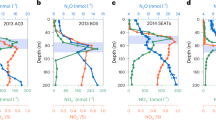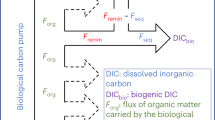Abstract
UPTAKE of atmospheric CO2 by the ocean's 'biological pump' is driven by export of carbon from the euphotic zone to deeper waters1,2. As nitrate is a limiting nutrient in large regions of the ocean, measurements of nitrate uptake are often used to estimate the amount of carbon exported in this way3–6. This presupposes knowledge of the molar C: N ratio in the organic material exported from the upper waters, which is usually taken to be 6.6 (the Redfield ratio7,8). Recent studies have suggested, however, that the consumption ratio of C:N may deviate from this value in coastal waters9–11. Here we present time-series from both coastal waters and open-ocean sites which demonstrate that net organic carbon production greatly exceeded that predicted from nitrate consumption and the Redfield C:N ratio. We found a similar discrepancy in sections across broad regions of the North Atlantic during eutrophic periods. Our results suggest that extrapolating from nitrate consumption using the Redfield ratio leads to significant underestimates of organic carbon export from the euphotic zone.
This is a preview of subscription content, access via your institution
Access options
Subscribe to this journal
Receive 51 print issues and online access
$199.00 per year
only $3.90 per issue
Buy this article
- Purchase on Springer Link
- Instant access to full article PDF
Prices may be subject to local taxes which are calculated during checkout
Similar content being viewed by others
References
Volk, T. & Hoffert, M. I. in The Carbon Cycle and Atmospheric CO2 Natural Variations Archean to Present (Sundquist, E. T. & Broecker, W. S.) 99–110 (AGU, Washington, 1985).
Sarmiento, J. L. & Sundquist, E. T. Nature 356, 589–593 (1992).
Eppley, R. W. & Peterson, B. J. Nature 282, 677–680 (1979).
Eppley, R. W., Renger, E. H. & Betzer, P. R. Deep-Sea Res. 30, 311–323 (1983).
Chavez, F. P. & Barber, R. T. Deep-Sea Res. 34, 1220–1243 (1987).
Platt, T. et al. Mar. Ecol. Progr. Ser. 52, 77–88 (1989).
Redfield, S. C., Ketchum, B. H. & Richards, F. A. in The Sea (ed. Hill, M. N.) 26–77 (Wiley New York, 1963).
Takahashi, T., Broecker, W. S. & Langer, S. J. geophys. Res. 90, 6907–6924 (1985).
Codispoti, L. A., Friederich, G. E. & Hood, D. W. Continental Shelf Res. 5, 133–160 (1986).
Karl, D. M., Tilbrook, B. D. & Tien, G. Deep-Sea Res. 38, 1097–1126 (1991).
Sambrotto, R. N. & Langdon, C. Continental Shelf Res. (in the press).
Jenkins, W. J. & Goldman, J. C. J. mar. Res. 43, 465–491 (1985).
Jenkins, W. J. Nature 331, 521–523 (1988).
Emerson, S., Quay, P., Stump, C., Wilbur, D. & Knox, M. Global biogeochem. Cycles 5, 49–69 (1991).
Minas, H. J. ICES Marine Sci. Symp. Series (eds Li, W. K. W. & Maestrini, S. Y.) (International Council for the Exploration of the Sea, Copenhagen, in the press).
Cooper, L. H. N. J. mar. biol. Assoc. UK 18, 677–728 (1933).
Chipman, D., Marra, J. & Takahashi, T. Deep-Sea Res. 40, 151–169 (1993).
Savidge, G. et al. Progr. Oceanogr. 29, 235–281 (1992).
Watson, A. J., Robinson, C., Robertson, J. E., Williams, P. J. le B. & Fasham, M. J. R. Nature 350, 50–53 (1991).
Esaias, W. E., Feldman, G. C., McClain, C. R. & Elrod, J. A. Eos. 67, 835–837 (1986).
Carpenter, E. J. & Romans, K. Science 254, 1356–1358 (1991).
Duce, R. A. in The Role of Air-Sea Exchange in Geochemical Cycling (ed. Baut-Menard, P.) 497–530 (Reidel, Dordrecht, 1986).
Huntley, M. E., Lopez, M. D. G. & Karl, D. M. Science 253, 64 (1991).
Schulenberger, E. & Reid, J. L. Deep-Sea Res. 28, 901–919 (1981).
Karl, D. M. Int. Geosphere-Biosphere Progr. Symp. Global Change Tokyo, April, 1992 (in the press).
Martin, J. H., Knauer, G. A., Karl, D. M. & Broenkow, W. W. Deep-Sea Res. 34, 267–285 (1987).
Hood, D. W. & Codispoti, L. A. in The Potential Effects of Carbon Dioxide Induced Climatic Change in Alaska (ed. McBeath, J. H.) 33–39 (Univ. of Alaska, 1984).
Sambrotto, R. N., Martin, J. H., Broenkow, W. W., Carlson, C. & Fitzwater, S. E. Deep-Sea Res. 40, 441–457 (1993).
Glover, D. M. & Brewer, P. G. Deep-Sea Res. 35, 1525–1546 (1988).
Author information
Authors and Affiliations
Rights and permissions
About this article
Cite this article
Sambrotto, R., Savidge, G., Robinson, C. et al. Elevated consumption of carbon relative to nitrogen in the surface ocean. Nature 363, 248–250 (1993). https://doi.org/10.1038/363248a0
Received:
Accepted:
Issue Date:
DOI: https://doi.org/10.1038/363248a0
This article is cited by
-
Seasonal dynamics of seawater CO2 system at a coastal site near the southern tip of Izu Peninsula, Japan
Journal of Oceanography (2020)
-
Effect of light on the growth of non-nitrogen-fixing and nitrogen-fixing phytoplankton in an aquatic system
Journal of Mathematical Biology (2016)
-
Inefficient microbial production of refractory dissolved organic matter in the ocean
Nature Communications (2015)
-
Classification of estuaries in China based on eutrophication susceptibility to nutrient load
Science China Earth Sciences (2015)
-
Enhanced biological carbon consumption in a high CO2 ocean
Nature (2007)
Comments
By submitting a comment you agree to abide by our Terms and Community Guidelines. If you find something abusive or that does not comply with our terms or guidelines please flag it as inappropriate.



